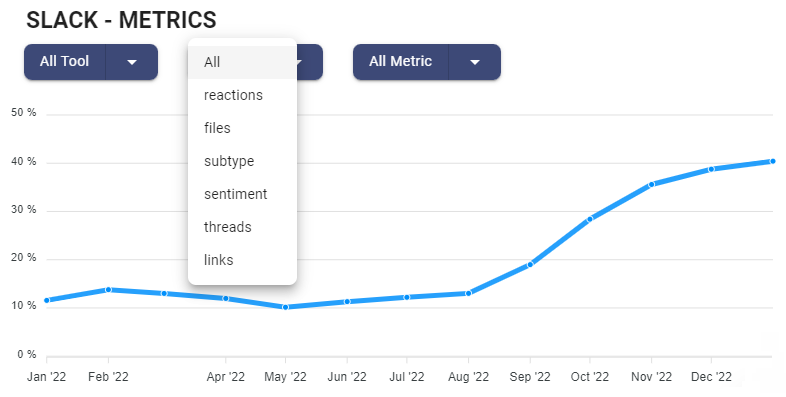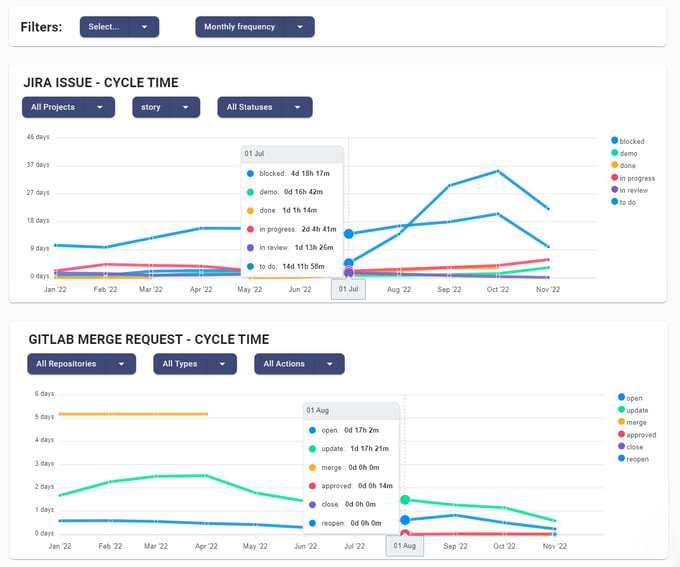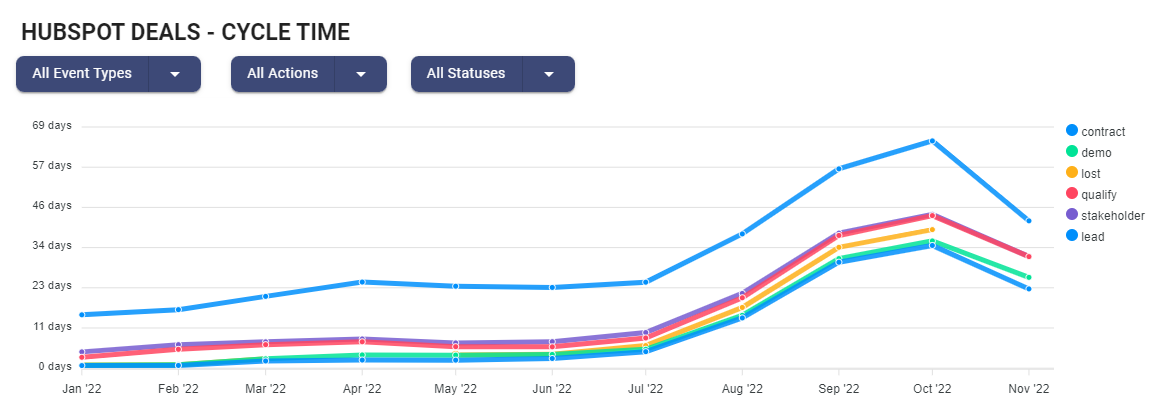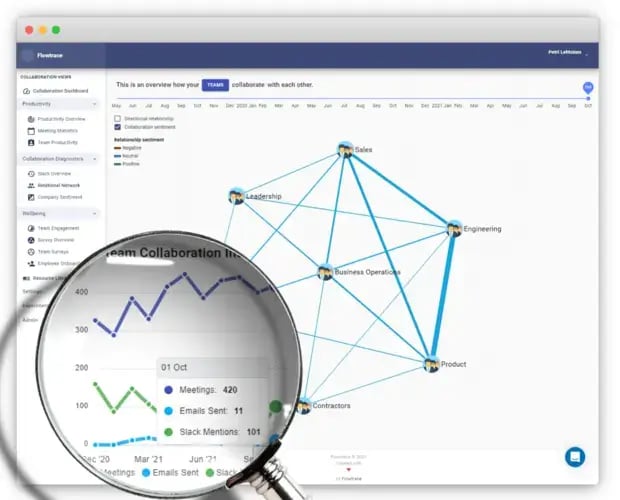Tackling Meeting Overload with Meeting Analytics
Discover how meeting analytics can tackle meeting overload, boost productivity, and revolutionize collaboration in the workplace. Gain insights on...
Visibility into workplace productivity and processes has never been more important. Read our guide for root causes and how to create a productive workplace
In today's fast-paced and constantly changing workplace, productivity is more important than ever. But with so many distractions and competing priorities, it can be difficult to stay on track and achieve your goals. In this article, we explore the root causes of productivity issues and provide practical tips and best practices for streamlining processes, breaking down silos, and using technology to enhance productivity. From measuring and tracking your progress to creating a culture of productivity, this guide will help you go from overwhelmed to overachieving in the workplace.
Productivity is a crucial aspect of success in today's constantly changing workplace. With more demands on our time and attention, it's increasingly difficult to stay focused and achieve our goals. This can lead to feelings of frustration and burnout, which in turn can affect our performance and well-being. In this guide, we'll explore the challenges of productivity in the modern workplace and provide practical tips and best practices for overcoming these obstacles and enhancing productivity.
From endless meetings and competing priorities to distractions and silos between teams, there are many factors that can impact productivity in the workplace. These issues can lead to a feeling of being overwhelmed, which in turn can impact motivation and morale. This is why it's important to understand the root causes of productivity issues and implement strategies for streamlining processes, breaking down silos, and enhancing productivity.
In this chapter, we provided a brief overview of the key challenges faced by organizations today and how these challenges can impact productivity. This will set the stage for the rest of the guide, which will provide best practices for overcoming these obstacles and enhancing productivity. So whether you're a manager, leader, or individual contributor, this guide will help you go from overwhelmed to overachieving in the workplace.
In order to enhance productivity in the workplace, it's important to first understand the root causes of productivity issues. This can help us to identify and prioritize the areas that need attention and implement strategies that will have the biggest impact. Some common root causes of productivity issues include:
Meeting overload: Too many meetings can be overwhelming and time-consuming, leaving little time for focused work.
Information silos and siloed teams: Teams that work in silos can struggle to collaborate effectively, leading to miscommunication and inefficiencies.
Outdated information and lack of sharing: Outdated information and a lack of sharing can make it difficult for employees to access the information they need to do their jobs effectively.
Poorly managed remote work: Remote work can make it difficult for teams to stay connected and collaborate effectively, leading to communication issues and a lack of visibility into processes.
Distractions: Distractions can be a major barrier to productivity, causing us to lose focus and be less productive.
In this chapter, we'll dive deeper into each of these root causes and explore how they can impact productivity in the workplace. This will help us to better understand the challenges we face and how to address them. By understanding the root causes of productivity issues, you'll be in a better position to create a more productive and efficient workplace.
Meetings are a necessary part of modern work, but when they become overwhelming and time-consuming, they can be a major barrier to productivity. Many workers today are struggling with meeting overload, with back-to-back meetings taking up much of their day and leaving little time for focused work. This can lead to burnout, decreased engagement, and decreased productivity.

There are several reasons why meetings can become overwhelming:
Too many meetings: When employees are constantly in meetings, they have little time to complete their work and can become overburdened.
Poorly organized meetings: Meetings that are poorly organized or poorly managed can be a waste of time and can leave employees feeling frustrated and disengaged.
Unproductive meetings: Meetings that lack clear agendas, action items, and outcomes can be unproductive and can leave employees feeling frustrated.
In order to tackle meeting overload, there are several best practices that can be implemented. These include:
Prioritizing meetings: It's important to prioritize meetings and only attend the ones that are essential.
Streamlining meetings: Meetings can be streamlined by using agendas, action items, and outcomes to ensure that they are productive and efficient.
Reducing the number of meetings: The number of meetings can be reduced by combining multiple meetings into one or by reducing the frequency of meetings.
Using technology to enhance meetings: Technology can be used to enhance meetings, from virtual meeting tools to meeting scheduling and management tools.
By implementing these best practices, organizations can reduce meeting overload and improve productivity in the workplace. By focusing on making meetings more productive and efficient, employees will have more time for focused work and will be better equipped to achieve their goals.
One of the biggest challenges in the modern workplace is the lack of inter-team collaboration. Teams often work in silos, using different tools for communication and collaboration, leading to inefficiencies, missed opportunities, and duplicated efforts. This can be especially problematic in large organizations where cross-functional processes require the cooperation and coordination of multiple teams.
To break down silos and promote collaboration, it's important to first understand the root causes of silos. Some common causes include:
To break down silos, leaders must take a proactive approach to promoting collaboration and cross-functional cooperation. Here are some tips:
By breaking down silos and promoting collaboration, organizations can improve efficiency, reduce duplicated efforts, and increase the effectiveness of cross-functional processes. With the right leadership and a commitment to collaboration, organizations can achieve a productivity culture and success.
One of the biggest obstacles to productivity in the workplace is the issue of outdated information and lack of sharing. When important documents are not updated or are stored in siloed systems, it becomes difficult for employees to access the information they need to do their jobs effectively. Additionally, when employees do not share information with each other, it can lead to duplication of effort, miscommunication, and missed opportunities.

To overcome these challenges, it is important to establish clear processes for sharing and updating information within your organization. This can include using cloud-based tools like Google Drive or Dropbox that allow multiple people to access and edit the same document at the same time. Additionally, it may be helpful to establish clear guidelines for who is responsible for updating certain documents and when they should be updated.
Another way to overcome the issue of outdated information is to promote a culture of sharing and collaboration. Encourage employees to share their knowledge and experience with one another, and create opportunities for cross-functional teams to work together on projects. By fostering a culture of openness and collaboration, you can ensure that everyone is on the same page and has access to the information they need to be productive.
Finally, consider implementing an intranet or internal communication platform where employees can share information and collaborate in real time. This can help to break down silos and improve communication across departments and teams. With the right tools and processes in place, your organization can overcome the challenges of outdated information and lack of sharing and become more productive and efficient.
Remote work has become increasingly common in today's world, with many companies opting for a flexible and decentralized workforce. While remote work offers a range of benefits, including improved work-life balance, flexibility and reduced commute time, it also presents new challenges when it comes to productivity. One of the biggest challenges is poorly managed remote work, which can have a negative impact on employee engagement, communication, and collaboration.
Challenges of Poorly Managed Remote Work: Poorly managed remote work often leads to feelings of isolation and disconnection, which can harm employee morale and productivity. Additionally, remote workers often struggle with distractions, lack of clear communication and structure, and a lack of visibility into their work. These challenges can be exacerbated by a lack of clear processes and expectations, which can lead to confusion and inefficiencies.
Best Practices for Managing Remote Work: To overcome these challenges and enhance productivity, companies must implement effective strategies for managing remote work. Some best practices include:
The Role of Technology in Enhancing Remote Work: Technology can play a major role in enhancing remote work, by providing the tools and resources needed to support effective communication and collaboration. Platforms like Flowtrace can help teams stay connected and informed, regardless of their location, by providing real-time insights and metrics into team performance and productivity.
Conclusion: In today's fast-paced and increasingly remote workplace, poorly managed remote work can have a major impact on productivity. However, with the right strategies and tools in place, companies can overcome these challenges and create a productive and engaged remote workforce. By prioritizing clear communication, collaboration, and technology, companies can ensure that their remote workers are as productive and effective as their in-person counterparts.

In today's digital age, distractions are everywhere. From constant notifications on our smartphones to endless email inboxes and social media feeds, it can be difficult to focus on what's important. When distractions start to interfere with our work, it can negatively impact our productivity, leading to wasted time and decreased job satisfaction. So, how can we minimize distractions and maintain our focus in the workplace?
Create a distraction-free environment. Start by removing distractions from your immediate workspace. Turn off notifications on your computer and phone, and minimize other distractions like background noise or visual clutter.
Set boundaries. Decide when and how you will respond to emails and other forms of communication. This might mean turning off email notifications during specific hours of the day or setting aside specific times to check and respond to messages.
Use tools and technologies to your advantage. There are many productivity tools available that can help you block out distractions, such as website blockers or noise-cancelling headphones. Experiment with different tools and find what works best for you.
Manage your time effectively. When we're busy, it can be easy to get caught up in a cycle of multitasking and distractions. To minimize distractions, prioritize your tasks and manage your time effectively. Focus on one task at a time and give it your full attention.
Establish a routine. Creating a routine and sticking to it can help you minimize distractions and stay focused on your work. Whether it's starting each day with a to-do list or taking regular breaks to stretch and recharge, find a routine that works for you and stick to it.
By following these strategies, you can minimize distractions and maintain your focus in the workplace. This will help you be more productive, stay on task, and achieve your goals.
The modern workplace is complex and constantly evolving, which can make it difficult to keep processes streamlined and silos from forming. However, streamlining processes and breaking down silos is essential for improving productivity and ensuring that teams are able to work together effectively.
One of the best ways to streamline processes is by standardizing them across departments and teams. This can involve creating policy templates, checklists, and guidelines that outline the steps involved in various tasks and projects. It also means ensuring that everyone is using the same tools and systems, which makes it easier to share information and collaborate.
Another important aspect of streamlining processes is to automate as much as possible. This can include tasks such as data entry, scheduling, and communication. By automating repetitive tasks, you free up time for more important tasks and reduce the risk of errors and inconsistencies.
Breaking down silos between teams is another critical step in improving productivity. This can involve creating cross-functional teams that bring together people from different departments and areas of expertise. These teams can work together to tackle projects and challenges, sharing information, knowledge, and skills along the way.

It is also important to encourage open communication and collaboration between teams. This can be done by using shared tools and platforms, such as chat apps and project management software. Additionally, you can create opportunities for teams to get together, such as regular cross-functional meetings or team building activities.
Finally, it is essential to regularly review and adjust your processes and systems to ensure that they are still effective and efficient. This can be done by collecting feedback from employees, conducting regular audits, and staying up-to-date with the latest technologies and best practices in your industry.
By streamlining processes and breaking down silos, you can create a more productive and effective workplace that supports teamwork, collaboration, and continuous improvement.
Technology has come a long way in recent years, and it can play a big role in improving productivity in the workplace. One of the biggest benefits of technology is its ability to provide real-time visibility into how work is being done, who is doing it, and how well it is being done. This information can be used to identify areas of the business that need improvement, track progress, and make data-driven decisions.
One of the biggest challenges facing businesses today is the need to manage multiple systems, tools, and platforms. This can lead to a lack of visibility into how work is being done, who is doing it, and how well it is being done. With the right technology in place, however, businesses can get a 360-degree view into their operations, making it easier to identify areas that need improvement and to track progress.
For example, a workplace analytics platform like Flowtrace can provide real-time visibility into meeting culture, communication, cross-functional collaboration, and team engagement metrics, allowing leadership teams to have a factual view of their internal workings. The platform can also help teams understand their relationship dynamics, uncover areas for improvement, and prioritize aspects of internal business to tackle first.

Another benefit of technology is the ability to automate processes and workflows, reducing the amount of time and effort required to complete tasks. For example, with a project management tool, teams can automate project tracking, time tracking, and task assignments, freeing up time to focus on higher-value activities.
Finally, technology can provide a way to measure and track productivity, allowing businesses to continuously improve and make data-driven decisions. For example, cycle time reports can provide insight into engineering cycle time, deal pipeline stage progression, and customer support response times, helping businesses make informed decisions about how to improve.
As we can see, the technology can play a crucial role in improving productivity in the workplace by providing real-time visibility, automating processes, and measuring and tracking productivity. By leveraging the right technology, businesses can achieve their productivity goals and create a more efficient, effective, and data-driven workplace.
In today's fast-paced and constantly changing business environment, visibility into workplace processes and productivity has never been more important. By understanding the root causes of productivity issues, streamlining processes, breaking down silos, and utilizing technology, organizations can achieve a culture of productivity and success.

Visibility provides the insights and data necessary to make informed decisions and drive continuous improvement. It allows organizations to measure and track their progress, identify areas for improvement, and make data-driven decisions that lead to greater efficiency and effectiveness. With the right tools and strategies in place, visibility has the power to transform the way we work, fostering a culture of productivity, collaboration, and success.
In conclusion, organizations that prioritize visibility and make a conscious effort to streamline processes and break down silos will be well positioned to achieve greater productivity and success. By embracing the power of visibility, organizations can make modern work truly visible and drive the continuous improvement necessary to thrive in today's competitive business landscape.
Discover how meeting analytics can tackle meeting overload, boost productivity, and revolutionize collaboration in the workplace. Gain insights on...
Want to boost productivity and streamline work processes? Workplace analytics can help! Identify inefficiencies and implement changes to drive...
Flowtrace's meeting analytics platform optimizes time management and productivity by providing insights into workplace calendars, and meetings.